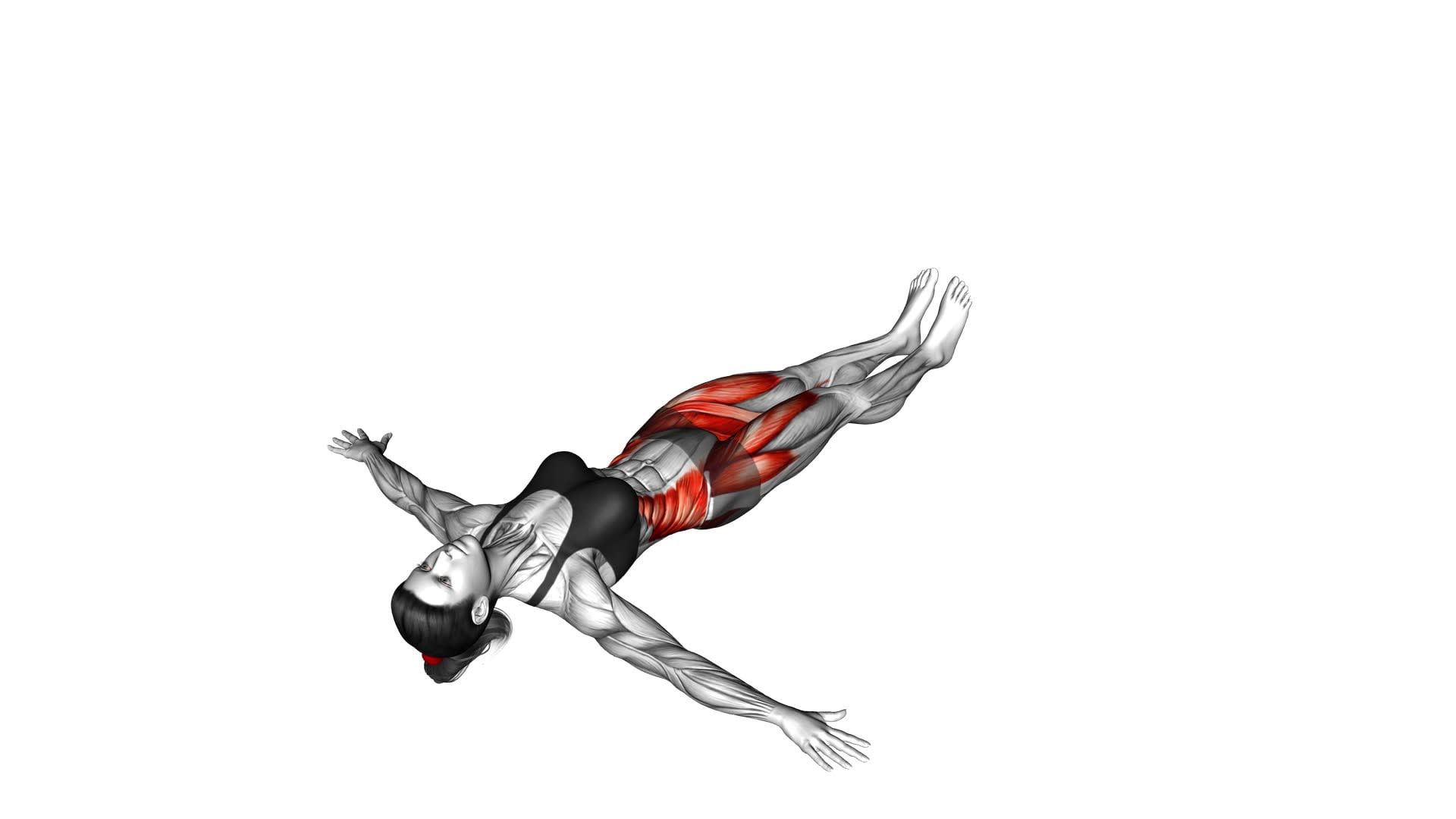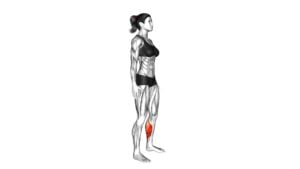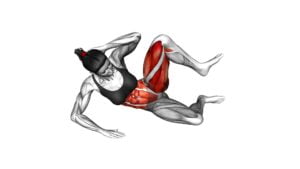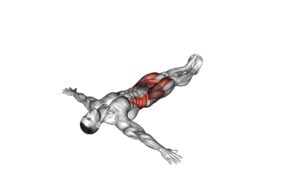Lying Side Stretch (female) – Video Exercise Guide & Tips

Get ready to stretch and strengthen your body with the Lying Side Stretch. In this quick and effective exercise, you'll target your core, hips, and obliques.
Watch This Exercise Video
Watch the video guide for step-by-step instructions and helpful tips to maximize your workout.
Whether you're a beginner or an experienced practitioner, this exercise can be modified to suit your fitness level.
So grab your mat and get ready to feel the burn!
Key Takeaways
- Lying Side Stretch helps prevent injuries and improves posture.
- Proper alignment and form are essential for performing the stretch correctly.
- Beginners can modify the stretch by starting with bent knees and gradually progressing.
- Advanced variations of the Lying Side Stretch can deepen stretches, improve flexibility, and enhance strength and balance.
Benefits of the Lying Side Stretch
Discover the numerous benefits of the lying side stretch for your body. This exercise isn't only great for injury prevention but also for flexibility training. By incorporating the lying side stretch into your routine, you can effectively increase the range of motion in your spine and hips, improving your overall flexibility.
One of the key benefits of this stretch is its ability to prevent injuries. By elongating the muscles and tendons in your sides, you can reduce the risk of strains and pulls during physical activity. Additionally, the lying side stretch helps to improve your posture by lengthening the muscles in your back, promoting proper alignment and reducing the chances of developing muscle imbalances.
Furthermore, this exercise is excellent for flexibility training. As you stretch your sides and hips, you're increasing the elasticity of the muscles, allowing them to move more freely. This increased flexibility can enhance your performance in various activities, such as yoga or dance.
Incorporating the lying side stretch into your fitness routine not only helps with injury prevention, but also enhances your flexibility. It's important to ensure that you perform this stretch with proper alignment and form to maximize its benefits.
Proper Alignment and Form
To maximize the benefits of the lying side stretch, ensure that you're maintaining proper alignment and form throughout the exercise. This won't only help you avoid injury but also ensure that you're targeting the intended muscles effectively.
One common misconception about the lying side stretch is that you need to forcefully pull your body into the stretch. However, this can lead to strain and discomfort. Instead, focus on maintaining a neutral spine and gently reaching your top arm overhead, allowing the stretch to naturally occur.
Another key alignment cue is to keep your hips stacked on top of each other, preventing any twisting or tilting. This will ensure that you're targeting the side muscles of your body evenly. Additionally, keep your bottom leg straight and extended, grounding it into the floor for stability.
Remember to breathe deeply throughout the stretch to enhance relaxation and flexibility. By paying attention to proper alignment and form, you can achieve the full benefits of the lying side stretch and prevent any unnecessary strain or injury.
Modifications for Beginners
If you're new to the lying side stretch, don't worry! There are easier pose variations that can help you gradually build strength and flexibility.
Start with a modified version by bending your knees and keeping your feet on the ground.
As you become more comfortable, you can gently progress by straightening your legs and reaching further with each stretch.
Easier Pose Variations
Try these three modified versions of the lying side stretch to make it easier for beginners. If you're finding the traditional lying side stretch too challenging, these alternative stretches can help you gradually build strength and flexibility.
First, you can start by bending your knees and placing a pillow or bolster between them for support. This modification reduces the intensity of the stretch and provides more stability.
Another option is to perform the stretch while lying on your back instead of your side. This variation allows for a gentler stretch while still targeting the same muscle groups.
Lastly, you can try performing the side stretch while seated in a chair, which further reduces the difficulty level.
Gentle Progression Tips
To achieve gentle progression as a beginner, focus on gradually increasing the difficulty level of the lying side stretch. Start by holding the stretch for a shorter duration, such as 10 to 15 seconds, and gradually increase the time as you become more comfortable.
Another modification you can make is to use a prop like a pillow or folded blanket to provide support to your torso. This will help ease the intensity of the stretch.
As you gain more flexibility and strength, you can progress to more challenging modifications, such as lifting your top leg or reaching your top arm overhead. Remember to listen to your body and only move on to advanced variations when you feel ready.
Now, let's explore some advanced variations for experienced practitioners.
Advanced Variations for Experienced Practitioners
Are you an experienced practitioner looking to take your practice to the next level? If so, it's time to explore challenging modifications that will test your strength and flexibility. These advanced variations will help you level up your practice and continue to challenge your body in new ways.
Get ready to push your limits and unlock new possibilities with the lying side stretch.
Challenging Modifications for Experts
Take your lying side stretch to the next level with these advanced variations for experienced practitioners. Here are five challenging modifications and advanced techniques to enhance your practice:
- Extended Leg Variation: Extend your top leg straight out in front of you, engaging your core muscles and deepening the stretch.
- Arm Overhead Variation: Reach your top arm overhead, lengthening through the side body and increasing the intensity of the stretch.
- Pulsing Variation: Add small pulses to your stretch by gently moving in and out of the stretch position, activating the muscles and increasing flexibility.
- Rotation Variation: Rotate your torso towards the ceiling, twisting your body and targeting different muscle groups.
- Dynamic Variation: Instead of holding the stretch, move in and out of the position, creating a dynamic flow and challenging your balance and stability.
These advanced modifications and techniques will push your boundaries, strengthen your body, and take your lying side stretch to new heights.
Leveling up Your Practice
Now, let's explore how you can elevate your practice with advanced variations and techniques for experienced practitioners.
As you continue to progress in your yoga journey, it's important to challenge yourself and take your practice to the next level. One way to do this is by incorporating progressing variations of poses, such as the Lying Side Stretch.
By exploring more advanced variations, you can deepen your stretches, improve flexibility, and enhance your overall strength and balance. Regular practice of these advanced variations can also bring additional benefits, such as increased body awareness, improved focus, and a greater sense of mental clarity.
Common Mistakes to Avoid
Avoid arching your back excessively during the lying side stretch. This common mistake can lead to injuries and prevent you from maximizing the flexibility benefits of this exercise. To ensure you're performing the lying side stretch correctly, here are some important points to keep in mind:
- Engage your core: Your core muscles play a vital role in maintaining proper form during the stretch. Focus on keeping your abdominal muscles engaged throughout the exercise to support your spine and prevent excessive arching.
- Maintain a neutral spine: Instead of arching your back, aim to keep your spine in a neutral position. Imagine lengthening your spine and keeping it straight throughout the stretch.
- Avoid pulling on your neck: Some people tend to pull on their neck while performing the lying side stretch. This can strain the neck muscles and take away from the effectiveness of the stretch. Keep your neck relaxed and focus on the side stretch sensation in your torso.
- Use proper breathing technique: Breathing deeply and rhythmically can help you relax into the stretch and enhance your flexibility. Inhale deeply as you prepare for the stretch and exhale as you move into the position.
- Start with a gentle stretch: It's important to start with a gentle stretch and gradually increase the intensity as your body becomes more flexible. Pushing yourself too hard too soon can lead to injuries.
Tips for Getting the Most Out of Your Lying Side Stretch
To maximize the benefits of your lying side stretch, consistently incorporate these tips into your routine.
- First, let's explore how to deepen your lying side stretch. As you perform the stretch, focus on engaging your core muscles and lengthening your spine. Take slow, deep breaths and try to sink deeper into the stretch with each exhale. You can also experiment with different arm positions to target specific areas. For example, reaching your top arm overhead can intensify the stretch in your side body.
- Another way to enhance your lying side stretch is by incorporating props. A yoga block or bolster can provide support and help you maintain proper alignment. Place the prop under your waist or between your legs to elevate your body and create a deeper stretch. You can also try using a strap to extend your reach and increase flexibility. Simply loop the strap around your top foot and gently pull to deepen the stretch.
Frequently Asked Questions
How Often Should I Perform the Lying Side Stretch to See Results?
To see results from the lying side stretch, you should perform it regularly. The lying side stretch has many benefits, including improved flexibility and reduced muscle tension.
There are also variations of the lying side stretch that you can try to target different muscle groups.
Can I Do the Lying Side Stretch if I Have a Back Injury?
If you have a back injury, it's important to modify exercises to avoid aggravating it. The lying side stretch may not be suitable for you in this case. Instead, try alternatives that are gentle on your back, such as seated side stretches or standing side bends.
These exercises can still help stretch your side muscles without putting excessive strain on your back. Remember to consult with a healthcare professional before starting any exercise routine, especially if you have a back injury.
Is It Normal to Feel Discomfort or Pain During the Lying Side Stretch?
Feeling discomfort or pain during the lying side stretch isn't uncommon. It's important to listen to your body and stop if the pain becomes too intense. Discomfort can be a sign that you're pushing your limits, but it shouldn't be severe or unbearable.
If you experience persistent pain, it's advisable to consult a healthcare professional. Remember to take it slow and gradually increase the intensity of the stretch to avoid injury.
Can I Incorporate Props or Equipment to Enhance My Lying Side Stretch?
You can definitely incorporate props or equipment to enhance your lying side stretch. Using a yoga block or bolster can provide additional support and help deepen the stretch.
Placing a towel or blanket under your body can also add comfort and cushioning.
Experiment with different props and find what works best for you. Remember to listen to your body and adjust as needed to ensure a safe and effective stretch.
How Long Should I Hold the Stretch Position During the Lying Side Stretch?
When doing the lying side stretch, you might be wondering how long to hold the stretch position. The duration of the stretch can vary depending on your fitness level and flexibility.
It's generally recommended to hold the stretch for about 15 to 30 seconds on each side. However, if you're looking for more flexibility and results, you can hold the stretch for up to 60 seconds.
Remember to incorporate the lying side stretch into your workout routine regularly for optimal benefits.
Conclusion
In conclusion, the lying side stretch is a beneficial exercise for improving flexibility and strengthening the core muscles.
It's important to maintain proper alignment and form to avoid injury and maximize the benefits of the stretch.
Beginners can modify the exercise by using props or starting with easier variations, while experienced practitioners can challenge themselves with advanced variations.
By avoiding common mistakes and following these tips, you can get the most out of your lying side stretch.

Author
Years ago, the spark of my life’s passion ignited in my mind the moment I stepped into the local gym for the first time. The inaugural bead of perspiration, the initial endeavor, the very first surge of endorphins, and a sense of pride that washed over me post-workout marked the beginning of my deep-seated interest in strength sports, fitness, and sports nutrition. This very curiosity blossomed rapidly into a profound fascination, propelling me to earn a Master’s degree in Physical Education from the Academy of Physical Education in Krakow, followed by a Sports Manager diploma from the Jagiellonian University. My journey of growth led me to gain more specialized qualifications, such as being a certified personal trainer with a focus on sports dietetics, a lifeguard, and an instructor for wellness and corrective gymnastics. Theoretical knowledge paired seamlessly with practical experience, reinforcing my belief that the transformation of individuals under my guidance was also a reflection of my personal growth. This belief holds true even today. Each day, I strive to push the boundaries and explore new realms. These realms gently elevate me to greater heights. The unique combination of passion for my field and the continuous quest for growth fuels my drive to break new ground.







